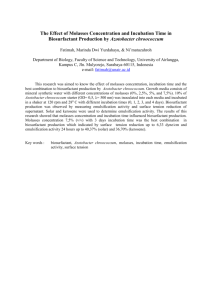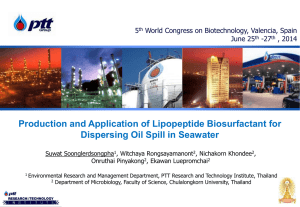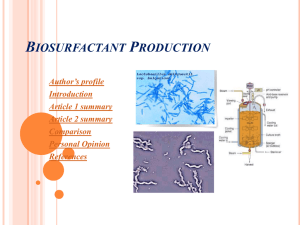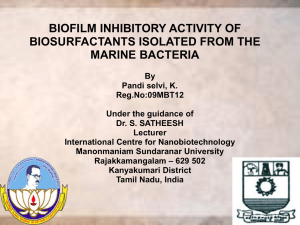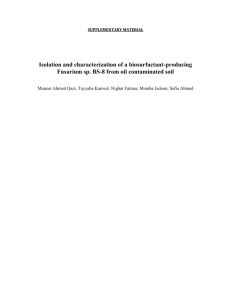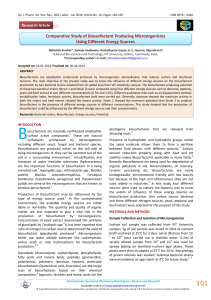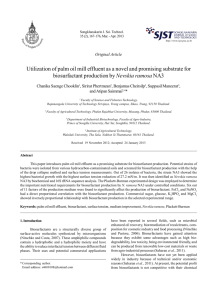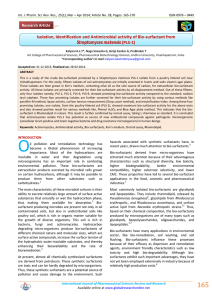Production of Biosurfactant by Locally Isolated Thermophilic Facultatively
advertisement
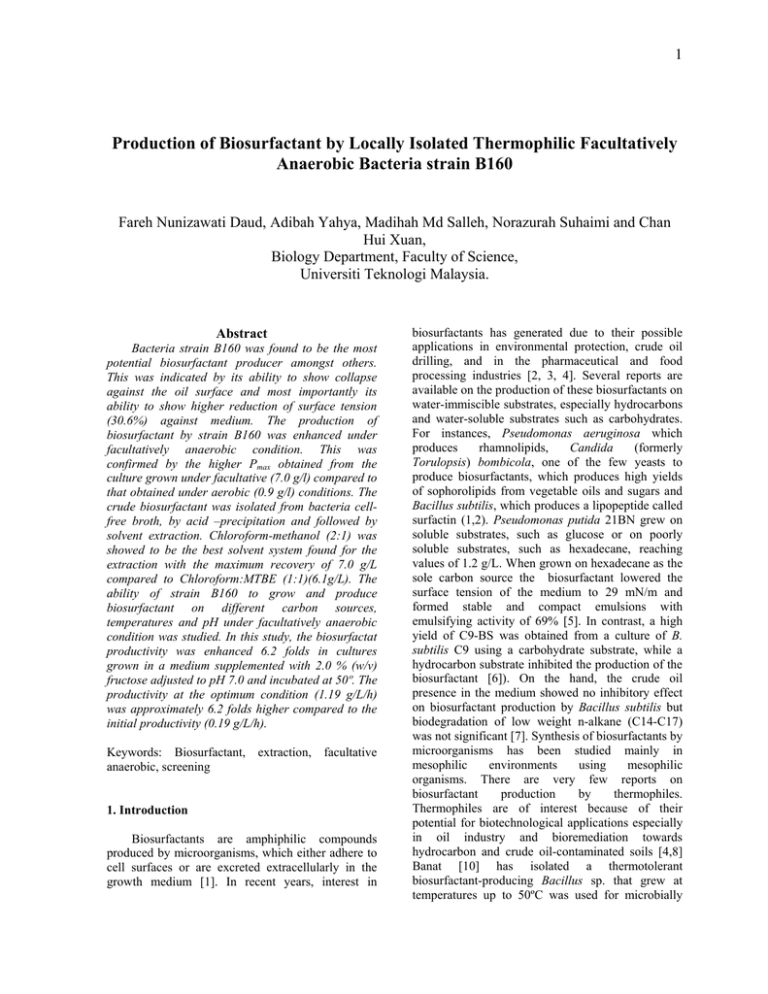
1 Production of Biosurfactant by Locally Isolated Thermophilic Facultatively Anaerobic Bacteria strain B160 Fareh Nunizawati Daud, Adibah Yahya, Madihah Md Salleh, Norazurah Suhaimi and Chan Hui Xuan, Biology Department, Faculty of Science, Universiti Teknologi Malaysia. Abstract Bacteria strain B160 was found to be the most potential biosurfactant producer amongst others. This was indicated by its ability to show collapse against the oil surface and most importantly its ability to show higher reduction of surface tension (30.6%) against medium. The production of biosurfactant by strain B160 was enhanced under facultatively anaerobic condition. This was confirmed by the higher Pmax obtained from the culture grown under facultative (7.0 g/l) compared to that obtained under aerobic (0.9 g/l) conditions. The crude biosurfactant was isolated from bacteria cellfree broth, by acid –precipitation and followed by solvent extraction. Chloroform-methanol (2:1) was showed to be the best solvent system found for the extraction with the maximum recovery of 7.0 g/L compared to Chloroform:MTBE (1:1)(6.1g/L). The ability of strain B160 to grow and produce biosurfactant on different carbon sources, temperatures and pH under facultatively anaerobic condition was studied. In this study, the biosurfactat productivity was enhanced 6.2 folds in cultures grown in a medium supplemented with 2.0 % (w/v) fructose adjusted to pH 7.0 and incubated at 50º. The productivity at the optimum condition (1.19 g/L/h) was approximately 6.2 folds higher compared to the initial productivity (0.19 g/L/h). Keywords: Biosurfactant, extraction, facultative anaerobic, screening 1. Introduction Biosurfactants are amphiphilic compounds produced by microorganisms, which either adhere to cell surfaces or are excreted extracellularly in the growth medium [1]. In recent years, interest in biosurfactants has generated due to their possible applications in environmental protection, crude oil drilling, and in the pharmaceutical and food processing industries [2, 3, 4]. Several reports are available on the production of these biosurfactants on water-immiscible substrates, especially hydrocarbons and water-soluble substrates such as carbohydrates. For instances, Pseudomonas aeruginosa which produces rhamnolipids, Candida (formerly Torulopsis) bombicola, one of the few yeasts to produce biosurfactants, which produces high yields of sophorolipids from vegetable oils and sugars and Bacillus subtilis, which produces a lipopeptide called surfactin (1,2). Pseudomonas putida 21BN grew on soluble substrates, such as glucose or on poorly soluble substrates, such as hexadecane, reaching values of 1.2 g/L. When grown on hexadecane as the sole carbon source the biosurfactant lowered the surface tension of the medium to 29 mN/m and formed stable and compact emulsions with emulsifying activity of 69% [5]. In contrast, a high yield of C9-BS was obtained from a culture of B. subtilis C9 using a carbohydrate substrate, while a hydrocarbon substrate inhibited the production of the biosurfactant [6]). On the hand, the crude oil presence in the medium showed no inhibitory effect on biosurfactant production by Bacillus subtilis but biodegradation of low weight n-alkane (C14-C17) was not significant [7]. Synthesis of biosurfactants by microorganisms has been studied mainly in mesophilic environments using mesophilic organisms. There are very few reports on biosurfactant production by thermophiles. Thermophiles are of interest because of their potential for biotechnological applications especially in oil industry and bioremediation towards hydrocarbon and crude oil-contaminated soils [4,8] Banat [10] has isolated a thermotolerant biosurfactant-producing Bacillus sp. that grew at temperatures up to 50ºC was used for microbially 2 enhanced oil recovery (MEOR) and oil–sludge clean up [10]. Furthermore, biosurfactant produced from Pseudomonas aeruginosa strain P-CG3 was effectively enhanced the bioavailability and biodegradation of phenanthrene (PHE) with 28-fold increased at 50ºC [4]. In this paper, we report the screening for the most potential thermophilic biosurfactant producer and its production under various conditions. 2. Material and methods 2.1 Microorganisms Sixteen locally isolated thermophilc facultatively anaerobic bacteria locally isolated from several oil reservoirs in Malaysia were screened for their ability to produce biosurfactant. The most potential biosurfactant producer was used for further study. 2.2 Media and culture conditions Medium composed of basal salts containing (g/L): NH4NO3 (4.0), Na2HPO4 (5.9), KH2PO4 (4.1), NaCl (0.5), MgSO4 (0.096), CaCl2 (7.74 x 10-4) and Na2EDTA (1.48 x 10-3) at pH 7 and supplemented with glucose (2 % w/v) as the substrate was used for the preparation of inoculum. The same medium was also used for the production of biosurfactant except that the source of substrate, pH and temperature was varied. The respective carbohydrate (glucose, fructose, sucrose, soluble starch and tapioca starch) were added to make the final concentrations of 2.0 % (w/v). The hydrocarbon substrates (hexadecane, kerosene and benzene) were also added separately at 2 % (v/v) concentration. For growth studies and biosurfactant production, the pH of the medium adjusted accordingly. Cultivation was done in 1-L flasks containing either 750mL or 300mL medium incubated with or without shaking at 150 rpm for facultative condition and aerobic growth conditions, respectively. Incubation temperatures were varied between 30ºC to70ºC. The experiment was conducted in duplicate. 2.3 Biomass determination Samples was taken at regular interval and growth was measured spectrophotometrically at 600 nm (Jenway, United Kingdom). The cell dry weight was obtained by using an expression of every 0.1 OD changes is equivalent to 0.61 mg/mL cell dry weight. This expression was obtained from a standard calibration curve of OD600 versus cell dry weight (mg/mL) at optimum growth condition. 2.4 Screening of biosurfactant producers Three different methods were used to aid the screening of potential biosurfactant producer. These includes: (i) Modified drop collapsed methods [11]. The shape of the beaded aliquot on the oil surface was observed visually each after 1 min, an hour and a day. If the drops remained beaded, the results score negative. Biosurfactant –producing culture gave flat drops and scored positive. Those cultures that still beaded after 24 hours were scored as negativeindicate to the lack of biosurfactant production. (ii) Blood haemolysis technique [12]. Bacteria were grown on blood agar at 37ºC. The formation of clearing zone around the colonies were observed. Those that produced β-hemolysis were potential producers. (iii) Surface tension measurement [13]. Measurements were made by using a Du-Nouy tensiometer (Krüss, Germany). All measurements were made on the cell-free broth obtained by centrifuging the cultures at 5000 rpm for 30 min. 2.5 Biosurfactant extraction Bacterial cells were removed from surfactantcontaining medium by centrifugation at 5000 rpm for 30 min. The supernatant was subjected to acid precipitation by adding HCl to achieve a final pH of 2.0 and kept at 4ºC overnight. The biosurfctant was extracted with mixture or single solvent system for 10 min. The biosurfactant was concentrated using a rotary evaporator [13]. Two different solvent systems used were (i) chloroform :methanol (2:1) (ii) MTBE: chloroform (1:1). The amounts of biosurfactant obtained were compared, respectively. 2.6 Measurement of emulsification index The method was according to Cooper and Goldenberg [14]. The emulsion stability was determined after 24 h. The emulsion index (E24) was calculated by measuring the emulsion layer formed. The result was expressed as the percentage of the emulsion layer. 3.0 Results and discussion Three methods have been successfully used for the screening of potential biosurfactant producer. Bacteria strain B160 was found to be the best candidate for the study of biosurfactant production under the influence of various environment and 3 aerobic conditions. The results showed that productivity of biosurfactant was significantly enhanced under facultatively anaerobic condition (0.154 g/L/h) compared to that under aerobic condition (0.002 g/L/h). Under facultative anaerobic condition, the maximum production of biosurfactant (Pmax) was more than six times higher (7.0 g/L) in comparison with that obtained under aerobic condition (0.91 g/L), with the maximum production rate (Qp) of 2.03 g/g/h. In both conditions, production of biosurfactant was found growth-associated. The bacterial strain B160 was also grew faster under oxygen-limited condition with the doubling time (td) of 0.218 h compared to when oxygen-riched condition was used (td=0.825 h). In principle, the higher the temperature, the concentration of atmospheric oxygen was also limited. Therefore, most thermophiles were adapted to grow and survive under limited oxygen condition compared to those of mesophiles [4, 19].This finding was also in common to that observed by Yakimov, et al. [9], using thermophilic B. lincheniformis isolated from a petroleum reservoir (at depth of 1,500 m) as biosurfactant producer. It has also been reported that in batch fermentation, biosurfactant could be utilized as substrate by the bacteria when the original source of substrate was limited [3, 18]. Therefore, this would contribute to the reduction of biosurfactant concentration in the growth medium during the stationary growth phase (Figure 1). 12.00 7.0 Cell dry weight (g/L) 6.0 8.00 5.0 6.00 4.0 3.0 4.00 2.0 2.00 1.0 0.00 Biosurfactant concentation (g/L) 8.0 10.00 0.0 0 6 12 24 30 33 36 39 42 Time (hour) (a) 7.00 0.90 0.80 5.00 0.70 0.60 4.00 0.50 3.00 0.40 0.30 2.00 0.20 1.00 Biosurfactant concentration (g/L) 1.00 6.00 Cell dry weight (g/L) medium conditions. The cell-free culture of strain B160 grown in liquid medium showed the fastest time to collapse on the oil surface and the highest reduction of surface tension (21.7mN/m) compared to others. However, formation of ß-haemolysis was not able to determine, as it did not grew on the blood agar. It has been previously reported that those that produced biosurfactant could caused ß-haemolysis due to complete red blood cell lysis [12]. In addition, more recent work has reported that blood agar may gave a large number of false results. This was due to other microbial products such as virulence factors which could also lyses blood cells or because of insufficient amount of biosurfactant produced which poorly diffused into the agar and failed to lyse the blood cells [15]. Furthermore, this bacteria was the most stably grown culture in the liquid medium used throughout this study with the specific growth rate of 0.206h-1. Biochemical characterization of this bacteria indicated the appearance of single and paired spore-forming rods, motile, facultatively anaerobes and able to grow on hydrocarbon. Surface tension measurement would be the choice of method to quantify biosurfactant production. However, it gave an indirect relationship to the concentration of biosurfactant available in the liquid [11, 13, 16]. Reduction of surface tension was indicative to the production of biosurfactant by the microbe. The higher reduction of surface tension would lead to the high concentration of biosurfactant available [13, 16]. However, biosurfactant were also occurred in the form of micelles at which point reduction of surface tension could not be determined anymore thus, the presence of increasing concentration of biosurfactant during prolonged incubation could not be measured [11, 17]. In this case, it was necessary to extract out the biosurfactant from the liquid medium and quantification was made based on its dry weight. Biosurfactant was lipid containing amphiphatic molecules that could be extracted using an appropriate organic solvent system. Various type of organic solvent could be used and they were applicable either singly or in combination for biosurfactant extraction [17]. In this study, two types of solvent systems were tested. Based on the amount of total biosurfactant recovered indicated that the mixture of chloroform and methanol at the ratio 2:1 (7.0 g/L) was the best system for the extraction compared to that extracted with equal volume of MTBE: Chloroform (6.1 g/L). Mixtures of solvents were commonly used to facilitate adjustment of the polarity between the solvent as the extraction agent and the biosurfactant to be extracted [17, 18]. Production of biosurfactant in batch system has been carried out under facultatively anaerobic and 0.10 0.00 0.00 0 2 4 6 8 10 12 14 Time (hour) (b) Figure 1: Production of biosurfactant by strain B160 under a) facultative anaerobic condition and b) aerobic condition. Symbol (··▲··) growth; (■) biosurfactant concentration. 4 Specific growth rate (h-1) 0.25 2 0.20 1.5 0.15 1 0.10 0.5 0.05 0 Biosurfactant productivity (g/L/h) 0.30 2.5 0.00 30 37 50 60 70 Various temperatures(oC) Figure 2: Effects of various temperatures on growth ( ) and biosurfactant productivity (■), by strain B160 grown at pH 6.5. However, the temperature of 50ºC was used in the following study as the productivity (0.19 g/L/h) was closely followed that at 30ºC and to suite the purpose of this research to study the production of biosurfactant at thermophilic conditions. This would be more advantageous for the application in extreme fields, such as oil reservoirs for enhanced oil recovery and bioremediation [8, 13]. 3 1.60 1.40 1.20 2 1.00 1.5 0.80 0.60 1 0.40 Maximum biosurfactant production (g/L) Specific growth rate (h-1) 2.5 0.5 than three days lag phase) when performed under non-shaking condition. However, growth and biosurfactant production was enhanced when the culture was shaken throughout the experiment. Prolonged lag growth phase obtained was related to the complexity of hydrocarbon metabolism due to its insolubility in water that lead to the more complex biochemical reactions [5, 7]. The maximum production of biosurfactant by B160 was obtained in the pH 7.0 medium supplemented with 2% (v/v) nhexadecane (10.0 g/L). This was 2- 3 times higher than those produced in 2 % (v/v) kerosene (3.0 g/L) and benzene (3.0 g/L), respectively. The ability of strain B160 to produce biosurfactant was found higher than reported for Pseudomonas putida 21BN with 1.2 g/L maximum production. The biosurfactant produced in hydrocarbon– containing medium was able to reduce surface tension to 29 mN/m and formed stable emulsions with emulsifying activity of 69 % [5]. When soluble (polar) substrates were used, the lag growth phase was significantly omitted. However, the maximum production of biosurfactant was notably lower compared to those obtained in medium-containing non-polar substrates. Figure 4 showed the effects of various types of soluble substrates to the biosurfactant productivity and specific growth rates of strain B160. Specific growth rate (h-1) and biosurfactant productivity (g/L/h) Temperature and pH were two environmental factors that majorly affect biological activities of prokaryotes [9, 13, 19]. Strain B160 showed the maximum production of biosurfactant when grown in medium at pH 7.0 and incubated at 50ºC. (Figure 3). Figure 2 showed that the highest productivity was obtained in culture grown at pH 6.5 and incubated at 30ºC (0.26 g/L/h). 3 2.5 2 1.5 1 0.5 0 soluble starch sucrose fructose glucose tapioca starch 0.20 Various carbon sources 0 0.00 5.5 6.0 6.5 7.0 7.5 Various pHs Figure 3: Effects of various pHs on growth ( ) and biosurfactant productivity (■), by strain B160 grown at 50ºC. Growth of strain B160 was found optimum at pH 7.5, incubated at 50ºC with the specific growth rate of 2.8 h-1, but, this bacteria showed the lowest biosurfactant productivity (0.11 g/L/h) at this pH. Production of biosurfactant aided the microbial metabolism of hydrocarbon (such as benzene, hexadecane, etc). As hydrocarbons was non-polar substrates, biosurfactant increased the bioavailability of the non-polar substrates by its emulsification properties [5, 13, 14]. Strain B160 capable of producing biosurfactant in hydrocarbon, though growth of the bacteria was extremely slow (more Figure 4: Effects of various carbon sources on specific growth rates (▄) of bacteria strain B160 and its biosurfactant productivity (▲). Bacteria strain B160 showed the highest productivity of biosurfactant in the medium supplemented with monosaccharide (glucose or fructose) in comparison with other carbohydrates (disaccharide and polysaccharide) tested. The highest productivity was obtained in glucosecontaining medium (1.37 g/L/h) followed by fructose (1.19 g/L/h). These productivities indicated to approximately 6-7 folds of total increment compared to that obtained before optimization (0.19 g/L/h). However, the maximum production (Pmax) was obtained in the medium supplemented with fructose (3.13 g/L) and able to form stable emulsion with 5 emulsifying activity of 58.8 %. The slight decreased of productivity in fructose containing medium was due to the longer tmax (2 hours) compared to that in glucose- containing medium (1 hour). The specific growth rates and biosurfactant production was found halted in starches containing media. This was indicated by the lowest specific growth rates (0.39 h-1 and 0.34 h-1 in soluble and tapioca starch, respectively) and biosurfactant production (0.56 g/L and 0.76 g/L in soluble and tapioca starch, respectively). In conclusion, the thermophilic bacterial strain B160 isolated from oil reservoir sample has a higher capacity to produce biosurfactant under facultatively aerobic condition, with hydrocarbon as the substrate at neutral pH with the maximum production of 10.0 g/L. However, production in soluble substrate was more preferable in large scale due to the simplicity for the recovery process [13, 18]. References [1] [2] [3] [4] [5] [6] [7] Mulligan, C.N. 2005. Environmental Applications for Biosurfactants. Environmental Polution. 133: 183198 Canter, N. 2004. The Benefits of Rhamnolipids Biosurfactants. Tribology and Lubrication Technology. 60 (12):13-15 Kuyukina, M.S., Ivshina, I.B., Makarov, S.O., Litvinenko, L.V., Cunningham, C.J. and Philip, J.C.. 2005. Effect of Biosurfactants on Crude Oil Desorption and Mobilization in Soil System. Environmental International. 31:155-161 Wong, J.W.C., Fang, M., Zhao Z., and Xing B. 2005. Effects of a surfactants on Solubilization and Degradation of Phenanthene under Thermophilic Conditions. Journal of Environmental Quality. 33(6): 2015-2025 Tulena, B. K., Ivanov, G. R., and Christova, N. E. 2001. Biosurfactant Production by a New Pseudomonas putida Strain. Z. Naturforsch. 57 (c): 365-360 Kim, H-S., Yoon, B-D., Lee, C-H., Suh, H-H., Oh, HM., Katsuragi, T. and Tani, Y. 1997. Production and Properties of a Lipopeptide Biosurfactant from Bacillus subtilis C9. Journal of fermentation and Bioengneering. 84(1):41-46 Queiroga, C.L., Nascimento, L. R., and Serra, G. E.. 2003. Evaluation of Paraffins Biodegradation and Biosurfactant Production by Bacillus subtilis in the present of Crude Oil. Brazillian Journal of Microbiology. 34:321-324 [8] [9] [10] [11] [12] [13] [14] [15] [16] [17] [18] [19] de Acevedo, G. T., and McInnerny, M.J. 1996. Emulsifying Activity in Thermophilic and Extremely Thermophilic Microorganisms. Journal of Industrial Microorganism. 16:1-7 Yakimov, M. M., Timmis, K. N., Wray, V., and Fredrickson, H. L. 1995. Characterization of a New Lipopeptide Surfactant Produced by Thermotolerant and Halotolerant Subsurface Bacillus lincheniformis BAS50. Applied and Environmental Microbiology. 61(5): 1706-1713 Banat, I.M. 1993. The Isolation of Thermophilic Biosurfactant Producing Bacillus sp. Biotechnology Letter. 15(6):591-594 Bodour, A. A. and Miller-Maier, R.M. 1998. Application of a Modified Drop-collapse Technique for Surfactant Quantification and Screening of Biosurfactant-producing Microorganism. Journal of Microbiological Methods. 32:273-280 Mulligan, C.N., Cooper, D.G., and Neufeld . R.J. 1984. Selection of Microbes Producing Biosurfactants in Media Without Hydrocarbons. Journal of Fermentation Technology. 62(4):311-314 Makkar, R.S., and Cameotra, S.S. 1997. Biosurfactant Production by a Thermophilic Bacillus subtilis strain. Journal of Industrial Microbiology and Biotechnology. 18:37-42 Cooper, D.G., and Goldenberg, B.G.. 1987. Surfaceactive Agent from Two Bacillus Species. Applied and Environmental Microbiology. 53:224-229 Youssef, N. H., Duncan, ., K.E., Nagle, D.P., Savage, K. N., Knapp, R. M., and McInerney, M. J. 2004. Comparison of Methods to Detect Biosurfactant Production by Diverse Microorganisms. Journal of Microbiological Methods. 56:339-347 Batista, S. B., Mounteer, A. H., Amorim, F. R., and Tόtola, M. R. 2006. Isolation and Characterization of Biosurfactant/bioemulsifier-producing Bacteria from Petroleum Contaminated Sites. Bioresource Technology. 97: 868-875 Kuyukina, M.S., Ivshina, I.B., Philp, J.C., Christofi, N., Dunbar, S.A., and Ritchkova, M.I. 2001. Recovery of Rhodococcus Biosurfactants using Methyl Tertiary-butyl ether extraction. Journals of Microbiological Methods. 46:149-156 Desai, J.D., and Banat, I. M. 1997. Microbial Production of Surfactants and Their Commercial Potential. Microbiology and Molecular Biology Reviews. 61(1):47-64 Cameotra, S.S., and Makkar, R.S. 1998. Synthesis of Biosurfactants in Extreme Conditions. Applied Microbiology Biotechnology. 50:520-529
